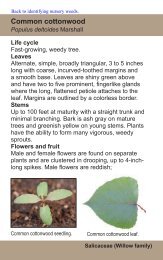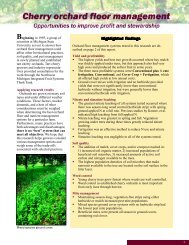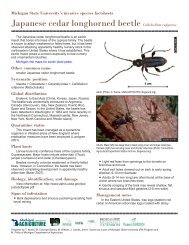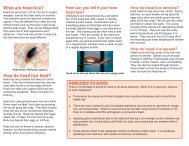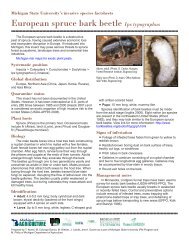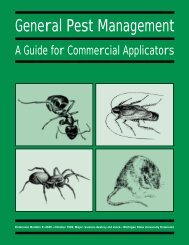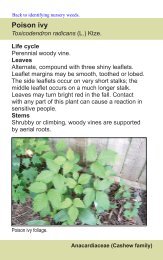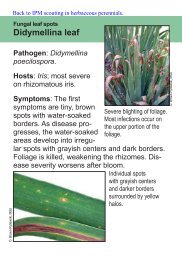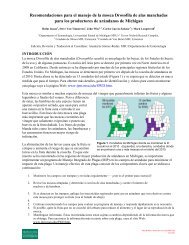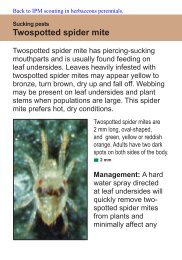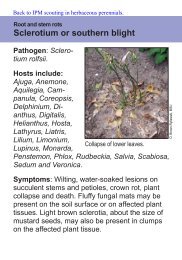CALIBRATION
CALIBRATION
CALIBRATION
You also want an ePaper? Increase the reach of your titles
YUMPU automatically turns print PDFs into web optimized ePapers that Google loves.
C<br />
H<br />
A<br />
P<br />
TE<br />
R 4<br />
<strong>CALIBRATION</strong><br />
LEARNING OBJECTIVES<br />
After completely studying this chapter, you should:<br />
■ Understand the purpose of calibration and why it is<br />
an essential process.<br />
■ Know the basic tools needed to calibrate sprayers and<br />
the variables that determine spray rate.<br />
■ Be able to check for and calculate nozzle output and<br />
know the guideline for determining when nozzles are<br />
worn out.<br />
■ Know what factors affect spray pattern uniformity<br />
and how to check for it.<br />
■ Understand how to calibrate a sprayer for broadcast<br />
application.<br />
■ Be able to calculate how much pesticide to add to the<br />
spray tank for broadcast application.<br />
■ Know how to properly calibrate a hand sprayer on a<br />
per acre basis and for a band application.<br />
■ Know how to calibrate granular applicators, both<br />
drop-through spreaders and rotary spreaders.<br />
INTRODUCTION<br />
The purpose of calibration is to ensure that your equipment<br />
delivers the correct amount of pesticide uniformly<br />
over the target area. Calibration is the step in pesticide<br />
application that is most often neglected and misunderstood.<br />
Because virtually every sprayer is a unique combination<br />
of pumps, nozzles, and other equipment, calibration<br />
is an essential process for an applicator to learn.<br />
For proper calibration, you will need a few basic tools,<br />
including a stopwatch, a collection container graduated<br />
in ounces, a tape measure, and flags or stakes for mark-<br />
ing. Unless your sprayer is new, it will contain a certain<br />
amount of pesticide residue; therefore, a pair of chemicalproof<br />
gloves is also recommended. Additionally, a pocket<br />
calculator will help with calculations.<br />
In this chapter, we provide formulas that are designed<br />
to make calibration easier for you. Some of these formulas<br />
have constants–i.e., numbers that remain the same<br />
whenever you use that formula. To make calibrations easier<br />
for you, we provide you with the constants.<br />
<strong>CALIBRATION</strong> OF SPRAYERS<br />
Calibrating a sprayer ensures that the sprayer is delivering<br />
the intended volume of spray mixture to the target<br />
area. You must determine each of the following:<br />
■ The amount of product the sprayer delivers per<br />
acre.<br />
■ The number of acres you can spray per tank.<br />
■ The recommended rate of pesticide application.<br />
■ The amount of pesticide to add to the spray tank.<br />
Variables That Determine the Spray Rate<br />
Two major variables affect the amount of spray mixture<br />
applied per acre (most commonly expressed in gallons<br />
per acre): the nozzle flow rate and the ground speed of<br />
the sprayer. You must understand the effect that each of<br />
these variables has on sprayer output to calibrate and<br />
operate your sprayer properly.<br />
Nozzle Flow Rate<br />
The flow rate through a nozzle varies with the nozzle<br />
pressure and the size of the nozzle tip. Increasing the<br />
pressure or using a nozzle tip with a larger opening will<br />
increase the flow rate (gallons per acre).<br />
Increasing pressure will NOT give you a proportional<br />
increase in flow rate. For example, doubling the pressure<br />
Field Crop Pest Management 25<br />
Chapter 4
will not double the flow rate–you must increase the pressure<br />
fourfold to double the flow rate.<br />
Sprayer pressure<br />
(speed constant)<br />
Sprayer output<br />
(gallons per acre)<br />
10 psi 10<br />
40 psi 20<br />
160 psi 40<br />
Pressure cannot be used to make major changes in<br />
spray rate, but it can be used to make minor changes.<br />
Keep in mind that operating pressure must be maintained<br />
within the recommended range for each nozzle<br />
type to obtain a uniform spray pattern and minimize<br />
drift.<br />
The easiest and most effective way to make a large<br />
change in flow rate is to change the size of the nozzle tips.<br />
Depending on operating pressure, the speed of the<br />
sprayer, and nozzle spacing, small changes in nozzle size<br />
can significantly change sprayer output per acre. Use nozzle<br />
manufacturers’ catalogs to select the proper tip size.<br />
Ground Speed of the Sprayer<br />
Provided the same throttle setting is used, as speed<br />
increases, the amount of spray applied per unit area<br />
decreases at an equivalent rate. For example, doubling<br />
the ground speed of a sprayer will reduce the amount of<br />
spray applied by one-half.<br />
Sprayer speed<br />
(under constant pressure)<br />
Sprayer output<br />
(gallons per acre)<br />
1 mph 40<br />
2 mph 20<br />
3 mph 13.3<br />
4 mph 10<br />
To determine the new output after changing speed:<br />
old output x old speed<br />
New output =<br />
new speed<br />
Some low-pressure sprayers are equipped with control<br />
systems that maintain a constant application rate over a<br />
range of travel speeds, provided the same gear setting is<br />
used. Pressure is automatically changed to vary the nozzle<br />
flow rate in proportion to changes in ground speed.<br />
Even so, do your calibration at a set ground speed. In the<br />
field, travel speed must be kept within certain limits to<br />
keep the nozzle pressure within the recommended range.<br />
Precalibration Check of Nozzle Output<br />
After making sure the system is clean, fill the tank<br />
approximately half full with water. Fasten a graduated<br />
container under each nozzle and operate the sprayer for<br />
one minute at a pressure within the recommended<br />
pressure range. Check to see that the flow rate from each<br />
nozzle is approximately the same; replace or clean any<br />
nozzle whose output differs by more than 5 percent from<br />
the average for all of the nozzles and again check the<br />
flow rates.<br />
For example, the following flow rates are obtained for<br />
six nozzles:<br />
Nozzle<br />
Output (ounces per minute)<br />
1 40.0<br />
2 43.0<br />
3 39.5<br />
4 40.5<br />
5 37.5<br />
6 39.5<br />
Total 240.0 ounces<br />
The average nozzle output is 40 ounces (2406).<br />
Five percent of 40 ounces (40 x 0.05) is 2 ounces. Any<br />
nozzle whose output differs from 40 ounces by more than<br />
2 ounces should be cleaned or replaced; that is, any nozzle<br />
whose output is greater than 42 or less than 38.<br />
Therefore, nozzle #5 should either be cleaned or replaced.<br />
The flow rate of nozzle #2 is too high. This indicates that<br />
the nozzle is worn and should be replaced.<br />
When the average nozzle output varies by more than<br />
10 percent from the manufacturer’s specifications, the<br />
nozzles are worn enough to justify the purchase of a new<br />
set. This is particularly important when using flat-fan or<br />
flood nozzles because proper spray overlap becomes difficult<br />
to maintain with worn nozzles.<br />
Spray Pattern Uniformity<br />
A uniform spray pattern is crucial for an effective pesticide<br />
application. It’s not enough to apply a pesticide<br />
only in its correct amount–you also must apply it uniformly<br />
over the target area. The effects of non-uniform<br />
application are most obvious when herbicide bands overlap<br />
and streaking results. Spray pattern uniformity is<br />
affected by boom height, spacing and alignment of nozzles<br />
on the boom, condition of nozzles (worn, damaged),<br />
and operating pressure. Check that all nozzles are of the<br />
same type. Also, a frequent cause of poor spray patterns<br />
is using nozzles with different spray angles on the same<br />
boom.<br />
To check the uniformity of the spray pattern, adjust the<br />
boom height for the spray angle and nozzle spacing<br />
being used. Align flat-fan nozzles at a slight angle to the<br />
boom. Using water, operate the sprayer at the desired<br />
speed and pressure on clean, dry pavement or on another<br />
smooth surface. Observe the spray pattern as the water<br />
evaporates. Clean or replace nozzle tips that produce a<br />
poor spray pattern; if necessary, readjust boom height<br />
and recheck the spray pattern. If you replace any nozzles,<br />
recheck the flow rates.<br />
Chapter 4<br />
26<br />
Field Crop Pest Management
Broadcast Sprayer Calibration<br />
There are a number of equally effective calibration<br />
methods that vary in their basic approach and degree of<br />
difficulty. For the purposes of this manual, we have chosen<br />
a simple method that will allow you to calibrate<br />
quickly.<br />
1. Fill the sprayer tank approximately half full with<br />
water.<br />
2. Determine the nozzle spacing or band width in<br />
inches and stake out the appropriate distance in the<br />
field according to the following table:<br />
Broadcast nozzle spacing or<br />
band width (inches)<br />
Travel distance<br />
(feet)<br />
8 510<br />
10 408<br />
12 340<br />
14 291<br />
16 255<br />
18 227<br />
20 204<br />
22 185<br />
24 170<br />
26 157<br />
For other nozzle spacings or band widths, determine<br />
the appropriate travel distance using the following<br />
formula:<br />
4,080<br />
Travel distance (feet) =<br />
nozzle spacing or band width (inches)<br />
In this formula, 4,080 is a constant.<br />
For example, if your nozzle spacing is 38 inches:<br />
4080 = 107 feet<br />
Travel distance =<br />
38<br />
Measuring the appropriate travel distance is a critical step<br />
in calibration. To determine what volume your sprayer is<br />
delivering per acre, you must relate the average nozzle<br />
output to a smaller unit area of land. You could determine<br />
the volume output by physically spraying an entire<br />
acre, but this would be very time consuming. Therefore,<br />
we use a fraction of an acre.<br />
3. With the sprayer turned off, drive the distance using<br />
the exact throttle setting and gear you plan to use during<br />
spraying. Be sure to note the throttle setting<br />
and gear; don’t rely on a speedometer. Start the spray<br />
rig about 25 feet before the staked area so that you will<br />
be at typical field speed at the beginning of the measured<br />
distance. Record your travel time in seconds.<br />
4. Adjust the pressure to the desired setting. Use slightly<br />
higher pressure when you use nozzle check valves and<br />
nozzle strainers.<br />
5. With the sprayer stationary, collect and record the output<br />
(in ounces) from at least four nozzles for the travel<br />
time recorded in step 3. Because we already determined<br />
that the output of all nozzles is within 5 percent of one<br />
another in the precalibration check, it is not necessary to<br />
collect output from all nozzles.<br />
6. Determine the average nozzle output in ounces.<br />
7. The spray rate in gallons per acre is equal to the average<br />
nozzle output in ounces. For example, if the average<br />
nozzle output for the recorded travel time is 20<br />
ounces, the spray rate is 20 gallons per acre.<br />
8. If the spray rate is not reasonable for your particular<br />
spraying job, you can change output by one of three<br />
methods: adjust pressure, change speed, or replace<br />
nozzle tips. If only a minor change in output is needed,<br />
simply make an adjustment in pressure and determine<br />
the new average nozzle output. (Remember that operating<br />
pressure must be kept within the recommended<br />
range for the nozzle type so that the spray pattern is<br />
not distorted.) If a large change in output is necessary,<br />
make a change in travel speed. However, you must<br />
drive the designated field distance and determine the<br />
new travel time before calculating the average nozzle<br />
output. If it is impossible to obtain the desired output<br />
at an appropriate pressure and ground speed, you will<br />
need to change nozzle tips; in this case, you must<br />
repeat the precalibration check of nozzle output.<br />
The sprayer is now calibrated. When operated at the<br />
designated speed and pressure, it should deliver the<br />
desired spray volume. You should occasionally remeasure<br />
output to determine if changes in flow rate occurred<br />
as a result of nozzle wear or other variations. If you continue<br />
to use the same travel speed used during initial calibration,<br />
it will take only a few minutes to recheck your<br />
sprayer’s output.<br />
Example: You want to make a postemergence broadcast<br />
application of a herbicide at a spray volume of 20 to<br />
30 gallons per acre using regular flat-fan nozzles spaced<br />
40 inches apart on the boom:<br />
1. Fill the sprayer tank approximately half full with<br />
water.<br />
2. The appropriate travel distance for 40-inch nozzle<br />
spacing is 102 feet; measure and mark this distance in<br />
the field.<br />
3. Using the throttle setting and gear you plan to use during<br />
spraying, you find that it takes 14 seconds to drive<br />
102 feet.<br />
4. Adjust the pressure to the desired setting within the<br />
recommended pressure range of 15 to 30 psi for regular<br />
flat-fan nozzles; your chosen setting is 25 psi.<br />
5. With the sprayer stationary, you collect the following<br />
outputs from four nozzles in 14 seconds:<br />
Nozzle<br />
Output (ounces per 14 seconds)<br />
1 15.5<br />
2 16<br />
3 15.5<br />
4 16<br />
Total = 63 ounces<br />
Field Crop Pest Management 27<br />
Chapter 4
6. The average output of the nozzles for 14 seconds is:<br />
63 ounces = 16 ounces<br />
4 nozzles<br />
7. The spray rate, therefore, is equal to 16 gallons per acre.<br />
8. The spray rate is lower than the recommended range of<br />
20 to 30 gallons per acre stated on the label. The major<br />
change in output required should not be attempted by<br />
increasing pressure. You’ll need to either decrease<br />
travel speed (in which case you’ll also need to determine<br />
the new travel time) or increase nozzle tip size.<br />
Then determine the new average output.<br />
Amount of Pesticide to Add to the Tank<br />
Your next step is to determine the amount of pesticide<br />
to add to the spray tank. To do so, you need to know:<br />
■ The recommended rate.<br />
■ The capacity of the spray tank.<br />
■ The calibrated output of the sprayer.<br />
You just learned how to determine the output of your<br />
sprayer.<br />
The recommended rate is determined from the label.<br />
Rates are expressed either as the amount of pesticide<br />
product applied per acre (or area) or as the amount to<br />
mix with a certain volume of water (or other carrier).<br />
Example: Broadcast application. Pesticide A is recommended<br />
as a broadcast application at a rate of 2 quarts<br />
per acre. Your sprayer has a 200-gallon tank and is calibrated<br />
to apply 20 gallons per acre. How much Pesticide<br />
A should you add to the spray tank?<br />
1. Determine the number of acres you can spray with<br />
each tank, using the following formula:<br />
tank capacity (gallons per tank) = 200 = 10 acres<br />
Acres per tank =<br />
Spray rate (gallons per acre) 20<br />
2. Determine the amount of pesticide to add to each<br />
tank, using the following formula:<br />
Amount per tank = acres per tank x rate per acre.<br />
With each tank, you cover 10 acres and you want to<br />
apply 2 quarts of product per acre:<br />
Amount per tank = 10 x 2 = 20 quarts.<br />
You need to add 20 quarts (5 gallons) of Pesticide A to<br />
each tank load.<br />
Example: Broadcast application. Pesticide B is an 80<br />
percent wettable powder formulation. After reading the<br />
label, you decide to apply 12 pounds per acre for perennial<br />
weed control. The area to treat is 150 feet wide and<br />
180 feet long. Your backpack sprayer is equipped with a<br />
three-nozzle boom, has a 4-gallon tank, and is calibrated<br />
to apply 40 gallons per acre of spray solution. How much<br />
water and product do you add to the tank? (43,560 sq. ft.<br />
= 1 acre)<br />
1. Calculate the area to be treated as follows:<br />
150 x 180 feet = 27,000 square feet, which is equal to<br />
0.62 acres (27,000 ÷ 43,560)<br />
2. Calculate the amount of water needed to cover 0.62<br />
acres, using this formula:<br />
40 gallons Y gallons =<br />
1 acre 0.62 acre<br />
which is read as “40 gallons is to one acre as<br />
Y gallons is to 0.62 acre.”<br />
Cross-multiplying:<br />
(Y x 1) = (40 x 0.62) = 24.8 gallons to treat 0.62 acre<br />
3. With a 4-gallon tank, we will need more than six<br />
loads of solution; let’s plan to mix seven loads.<br />
24.8 gallons = 3.54 gallons per load<br />
7 loads<br />
4. If we were spraying an acre, we would need 12<br />
pounds of pesticide per 40 gallons of water (the peracre<br />
output of our sprayer). However, we will be<br />
spraying only 3.54 gallons at a time. To determine<br />
the amount of pesticide to add per tank load, use<br />
the following formula:<br />
12 pounds Y pounds =<br />
=<br />
40 gallons 3.54 gallons<br />
Y= 12 x 3.54 1.06 pounds of Pesticide B in each<br />
=<br />
40 tank load of 3.54 gallons<br />
Liquid Application on a Percentage Basis<br />
Occasionally pesticide recommendations are expressed<br />
as amount of product per a specified volume of water. Such<br />
rates are expressed as “volume/volume” equivalents or as<br />
a percentage of product in the spray solution.<br />
Example: Rate expressed as volume per volume.<br />
Pesticide C is recommended as a sanitary bin spray to<br />
control stored grain insects. Four gallons of product are<br />
recommended per 100 gallons of water. You want to prepare<br />
75 gallons of solution. How much Pesticide C do<br />
you mix with the 75 gallons of water?<br />
4 gallons Pesticide C Y gallons Pesticide C<br />
=<br />
100 gallons water 75 gallons water<br />
By cross multiplying:<br />
100 x Y = 75 x 4<br />
100 x Y = 300<br />
Y = 3 gallons of Pesticide C per 75 gallons<br />
of water<br />
GRANULAR APPLICATOR <strong>CALIBRATION</strong><br />
Occasionally, granular or pelleted pesticides are used<br />
for weed control. The need for accurate calibration is just<br />
as great for granular applicators as for sprayers.<br />
The application rate of granular applicators depends on<br />
the size of the metered opening, the speed of the agitator<br />
Chapter 4<br />
28<br />
Field Crop Pest Management
or rotor, travel speed, the roughness of the site, and the<br />
flowability of the granules. The flow rate of granules<br />
depends on particle size, density, type of granule, temperature,<br />
and humidity. The manufacturer’s suggested setting<br />
should be used only as the initial setting for verification<br />
runs by the operator prior to use. A different applicator setting<br />
may be necessary for each pesticide applied; variations<br />
in flow rate also can occur with the same product<br />
from day to day or from site to site. It is therefore important<br />
to calibrate frequently to maintain the proper application<br />
rate.<br />
Apart from the actual setting of the metering opening,<br />
ground speed is the most significant factor affecting the<br />
application rate. You must use the same ground speed<br />
during calibration that you intend to use during the<br />
application, and the speed must remain constant.<br />
However, gravity-flow applicators use a rotating agitator,<br />
with speed varying with ground speed. The flow of granules<br />
through the opening is not necessarily proportional<br />
to speed. A speed change of 1 mile per hour may cause a<br />
significant variation in the application rate.<br />
Drop-through Spreaders<br />
Drop-through spreaders usually are calibrated using<br />
catch pans. Chain or wire catch pans beneath the spreader<br />
to collect granules as they are discharged. After covering<br />
a distance equivalent to 1/50 acre (871 sq. ft.), weigh<br />
the granules collected in the catch pan to determine the<br />
application rate. Use the table below to select the appropriate<br />
travel distance for your spreader.<br />
Swath width<br />
(feet)<br />
Travel distance<br />
(feet)<br />
1.5 581<br />
2 436<br />
3 290<br />
4 218<br />
5 174<br />
6 145<br />
7 124<br />
8 109<br />
9 97<br />
10 87<br />
11 79<br />
12 73<br />
15 58<br />
If your spreader has a different width, use this formula<br />
to calculate the travel distance:<br />
For example, if you have a spreader that covers a<br />
6.5-foot swath, the distance to travel is:<br />
871 = 134 feet<br />
6.5<br />
The step-by-step procedure for calibrating a dropthrough<br />
spreader is:<br />
1. Before starting, calculate how much material should be<br />
applied in the calibration area. You need to know only<br />
the recommended rate per acre and multiply this<br />
value by 1/50 (remember you will cover 1/50 acre in<br />
the calibration exercise).<br />
2. Measure out the travel distance as determined by the<br />
swath width of the spreader.<br />
3. Securely attach a collection pan to the spreader.<br />
4. Set the feeder gate control to the setting recommended<br />
in the owner’s manual or on the product label.<br />
5. Calibration must be done with the same granules you<br />
intend to use during application.<br />
6. Operate the spreader in the premeasured calibration<br />
area at the speed you intend to use during application.<br />
7. Weigh the amount of granules in ounces in the collection<br />
pan. Be sure to use a scale that can accurately measure<br />
to the nearest ounce.<br />
8. Compare the amount of product collected in the calibration<br />
area with the amount calculated in Step 1<br />
above. If they are within 5 percent of each other, the<br />
applicator is properly calibrated; if not, you need to<br />
adjust the feeder gate control and recalibrate.<br />
Example: A broadcast application of Pesticide D is to<br />
be made at a rate of 60 pounds of product per acre. Your<br />
equipment broadcasts granules in a 15-foot swath width.<br />
After covering a distance of 58 feet, you collect 16 ounces<br />
of granules. Is your applicator properly calibrated?<br />
1. Determine the amount of product in ounces that<br />
should be applied to the calibration area:<br />
(60 pounds) x (1/50) = 1.2 pounds x 16 ounces per<br />
pound = 19.2 ounces<br />
2. Determine if the amount actually applied (16 ounces) is<br />
within 5 percent of the recommended rate (19.2<br />
ounces):<br />
19.2 ounces x 0.05 (5%) = 0.96 ounces<br />
If your applicator was properly calibrated, it should<br />
have applied between 18.2 and 20.2 ounces of product to<br />
the calibration area. It actually applied less. You therefore<br />
need to adjust the feeder gate control to apply more<br />
material and then recalibrate.<br />
travel distance in feet =<br />
871<br />
swath width in feet<br />
Field Crop Pest Management 29<br />
Chapter 4
C<br />
4<br />
H<br />
A<br />
P<br />
TER<br />
Review Questions<br />
Chapter 4: Calibration<br />
6. Measuring and comparing the output of each nozzle<br />
to the average output of all the nozzles allows you to<br />
determine if:<br />
A. The pump is functioning properly.<br />
B. Any nozzle is worn or clogged.<br />
C. It is the right nozzle for the job.<br />
D. The pressure is accurate.<br />
Write the answers to the following questions and<br />
then check your answers with those in the back of<br />
the manual.<br />
1. Why is calibration of various spray systems essential?<br />
7. If the spray pattern is not uniform, you should:<br />
A. Check the boom height.<br />
B. Check the spacing and alignment of the nozzles on<br />
the boom.<br />
C. Check the operating pressure.<br />
D. Do all of the above.<br />
8. You determine the distance to travel for calibration by:<br />
A. Using a formula with a constant and the nozzle<br />
spacing.<br />
B. Reading it from the pesticide label.<br />
C. Reading it from the tractor handbook.<br />
2. Calibration ensures that the correct amount of pesticide<br />
is delivered uniformly over the target area.<br />
A. True<br />
B. False<br />
3. What happens to the flow rate if you increase the<br />
nozzle pressure or use a larger nozzle tip opening?<br />
A. Has no effect of the flow rate.<br />
B. Increases the flow rate.<br />
C. Decreases the flow rate.<br />
4. To double the flow rate, you must increase the<br />
pressure:<br />
A. Twofold.<br />
B. Threefold.<br />
C. Fourfold.<br />
D. Fivefold.<br />
5. If the throttle setting remains constant, and the speed<br />
doubles, the amount of spray per acre:<br />
A. Remains constant.<br />
B. Doubles<br />
C. Is reduced by half.<br />
D. Is reduced by one quarter.<br />
D. Setting an arbitrary distance based on the type of<br />
pesticide.<br />
9. Why is there an operating pressure range for each type<br />
of nozzle?<br />
A. To prevent nozzle clogging.<br />
B. To relieve strain on the pump.<br />
C. To keep the spray pattern from distorting.<br />
D. To calculate the travel distance.<br />
10. In a broadcast sprayer calibration, if the nozzle spacing<br />
is 30 inches, what is an appropriate distance to<br />
stake out in the field?<br />
A. 101 feet<br />
B. 136 feet<br />
C. 256 feet<br />
D. 1 acre<br />
11. In Question 10, it took 20 seconds to travel the appropriate<br />
distance. What does this travel time tell you?<br />
A. How long you should measure the output from<br />
nozzles.<br />
B. How long it will take to spray the entire field.<br />
C. How long it will take to empty the tank.<br />
D. Whether the sprayer is properly calibrated.<br />
Chapter 4<br />
30<br />
Field Crop Pest Management
12. When calibrating a broadcast sprayer, you find that<br />
the average nozzle output is 25 ounces for the recorded<br />
travel time. What is the spray rate in gallons per<br />
acre?<br />
A. 25 gallons per acre<br />
B. 30 gallons per acre<br />
C. 35 gallons per acre<br />
D. 40 gallons per acre<br />
13. What can you do if your calibrated spray rate is less<br />
than the recommended rate stated on the label?<br />
A. Increase the pressure.<br />
B. Decrease travel speed.<br />
C. Increase nozzle tip size.<br />
D. B and/or C.<br />
14. In a broadcast sprayer application, if the spray tank<br />
capacity is 150 gallons and the spray rate is 30 gallons<br />
per acre, how many acres can be sprayed per tank?<br />
A. 0.2 acres<br />
B. 0.5 acres<br />
C. 3 acres<br />
D. 5 acres<br />
16. How do you determine what rate of pesticide to<br />
apply?<br />
A. Use a formula.<br />
B. Read it off the spray tank.<br />
C. Read the pesticide label.<br />
D. All of the above.<br />
17. The flow rate of dry granular pesticide products:<br />
A. Varies because of many factors such as particle<br />
size and humidity.<br />
B. Remains constant from product to product.<br />
C. Prevents accurate calibration.<br />
D. Allows for less frequent calibration than liquid<br />
products.<br />
18. A broadcast application of granular pesticide is to be<br />
made at the rate of 30 pounds of product per acre.<br />
Your equipment broadcasts granules in a 10-foot<br />
swath. How many feet do you travel to calibrate your<br />
spreader?<br />
A. 218 feet<br />
B. 145 feet<br />
C. 87 feet<br />
D. 58 feet<br />
15. In Question 14, how much pesticide will you need to<br />
add per tank if the label recommends 4 quarts of<br />
product per acre?<br />
A. 10 quarts<br />
B. 20 quarts<br />
C. 30 quarts<br />
D. 40 quarts<br />
Field Crop Pest Management 31<br />
Chapter 4



